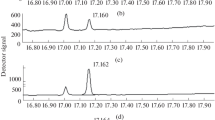Summary
A method for the quantitative determination of phenobarbital and free and conjugatedp-hydroxyphenobarbital in urine samples is described. The method includes initial extraction, purification on a small chromatographic column and finally determination by gas chromatography. The barbituric acids are methylated by trimethylanilinium hydroxide which serves as a “flash heater” methylating agent. The conjugate ofp-hydroxyphenobarbital, which appears to be a glucuronide, is hydrolysed with hydrochloric acid.
Similar content being viewed by others
References
Algeri, E.J., McBay, A.J.: Metabolite of phenobarbital in human urine. Science123, 183–184 (1956)
Atkinson, A.J., MacGee, J., Strong, J., Garteiz, D., Gaffney, T.E.: Identification of 5-meta-hydroxyphenyl-5-phenylhydantoin as a metabolite of diphenylhydantoin. Biochem. Pharmacol.19, 2483–2491 (1970)
Brochmann-Hanssen, E., Oke, T.O.: Gas chromatography of barbiturates, phenolic alkaloids, and xanthine bases: flash-heater methylation by means of trimethylanilinium hydroxide. J. pharm. Sci.58, 370–371 (1969)
Butler, T.C.: The metabolic hydroxylation of phenobarbital. J. Pharmacol. exp. Ther.116, 326–336 (1956)
Butler, T.C.: The metabolic conversion of 5,5-diphenylhydantoin to 5-(p-hydroxyphenyl)-5-phenylhydantoin. J. Pharmacol. exp. Ther.119, 1–11 (1957)
Chang, T., Glazko, A.J.: Quantitative assay of 5,5-diphenylhydantoin (Dilantin®) and 5-(p-hydroxyphenyl)-5-phenylhydantoin by gas-liquid chromatography. J. Lab. clin. Med.75, 145–155 (1970)
Chang, T., Savory, A., Glazko, A.J.: A new metabolite of 5,5-diphenylhydantoin (Dilantin®). Biochem. biophys. Res. Commun.38, 444–449 (1970)
Glasson, B., Benakis, A.: Etude du phénobarbital C-14 dans l'organisme du rat. Helv. Physiol. Pharmacol. Acta19, 323–334 (1961)
Grover, P.L., Hewer, A., Sims, P.: Epoxides as microsomal metabolites of polycyclic hydrocarbons. FEBS Letters18, 76–80 (1971)
Harvey, D.J., Glazener, L., Stratton, C., Nowlin, J., Hill, R.M., Horning, M.G.: Detection of a 5-(3,4-dihydroxy-1,5-cyclohexadien-1-yl)-metabolite of phenobarbital and mephobarbital in rat, guinea pig and human. Res. Commun. chem. Pathol. Pharmacol.3, 557–565 (1972)
Horning, E.C., Horning, M.G.: Metabolic Prophiles: Gas-phase methods for analysis of metabolites. Clin. Chem.17, 802–809 (1971)
Horning, M.G., Butler, C., Harvey, D.J., Hill, R.M., Zion, T.E.: Metabolism of N,2-dimethyl-2-phenylsuccinimide (methsuximide) by the epoxide-diol pathway in rat, guinea pig and human. Res. Commun. chem. Pathol. Pharmacol.6, 565–578 (1973)
Jalling, B., Boréus, L.O., Kållberg, N., Agurell, S.: Disappearance from the newborn of circulating prenatally administered phenobarbital. Europ. J. clin. Pharmacol.6, 234–238 (1973)
Jalling, B.: Plasma and cerebrospinal fluid concentration of phenobarbital in infants given single doses. Develop. Med. Child Neurol.16, 781–793 (1974)
Kållberg, N., Agurell, S., Boréus, L.O., Jalling, B.: Rapid gas chromatographic determination of phenobarbital in small plasma samples. Europ. J. clin. Pharmacol.3, 185–188 (1971)
Modin, R., Tilly, A.: Quantitative determinations by ion pair extraction. Ion pairs between quaternary ammonium ions and carboxylic acids and phenol. Acta pharm. suec.5, 311–322 (1968)
Nicholson, J.D.: The urinary excretion of phenobarbitone and pentobarbitone in the horse. Biochem. Pharmacol.17, 1–8 (1968)
Oesch, F., Morris, N., Daly, J.W., Gielen, J.E., Nebert, D.W.: Genetic expression of the induction of epoxide hydrase and aryl hydrocarbon hydroxylase activities in the mouse by phenobarbital or 3-methylcholanthrene. Mol. Pharmacol.9, 692–696 (1973)
Pierce, A.E., Rising, M.M.: Chemical studies of the mechanism of the narcosis induced by hypnotics. The synthesis of colored derivatives of phenobarbital. J. Amer. chem. Soc.58, 1361–1363 (1936)
Svendsen, A.B., Brochmann-Hanssen, E.: Gas chromatography of barbiturates II. Application to the study of their metabolism and excretion in humans. J. pharm. Sci.51, 494–495 (1962)
Author information
Authors and Affiliations
Rights and permissions
About this article
Cite this article
Kållberg, N., Agurell, S., Ericsson, Ö. et al. Quantitation of phenobarbital and its main metabolites in human urine. Eur J Clin Pharmacol 9, 161–168 (1975). https://doi.org/10.1007/BF00614013
Received:
Revised:
Issue Date:
DOI: https://doi.org/10.1007/BF00614013




